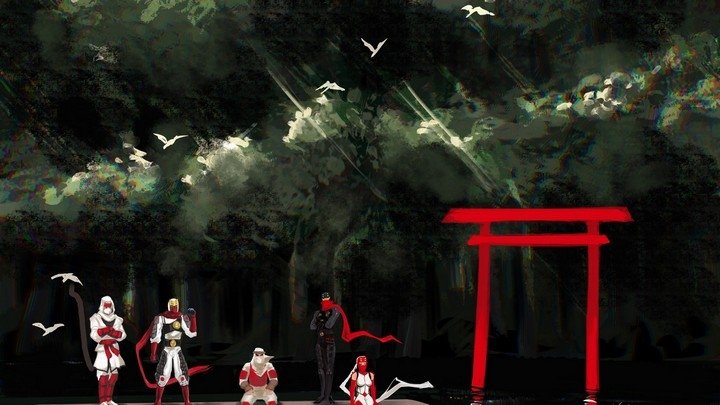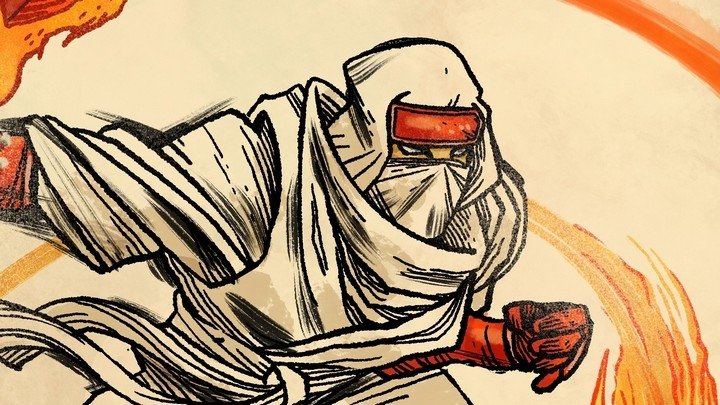The seven stars of the Fist of the North Star catalogue
A look back at the few warriors that survived the licensed game wasteland.
Just a few years ago, the very notion of SEGA localizing Fist of the North Star: Lost Paradise, the unlikely mashup of Tetsuo Hara's seminal Mad Max-meets-Bruce-Lee manga from the mid-'80s, Fist of the North Star, with Sega's own perennial gangster melodrama series, Yakuza, would have seemed completely ludicrous — the mainline Yakuza games were expensive, time-consuming endeavours that had repeatedly failed to find a foothold outside of Japan and the Fist of the North Star motif undoubtedly adds its own wrinkles, not least of which being the fact that the history of Fist of the North Star games is riddled with underwhelming pap.
Times have changed. Sega's merger with Atlus and renewed commitment to localize everything (that isn't a Virtual On game, anyway) has resulted in a western resurgence for the Yakuza series that has now cemented it as a popular and successful series across the globe; moreover, the Yakuza developers have managed the unthinkable: not only did they deliver the first respectable Fist of the North Star game in a decade, they delivered what might be the first unreservedly great 3D Fist of the North Star game ever.
In anticipation of the game's release this October, and in consideration with those who might simply have never played a Fist of the North Star game before, I've prepared a rundown of the essential Fist of the North Star titles from across the franchise's thirty-plus years of videogame ubiquity... or, to be blunt, I've whittled it down to the seven games that most creatively adapted the source material without tripping over their own feet. Seriously, for a franchise so tailor-fit for videogames, especially early videogames — burly guy wanders a post-apocalyptic wasteland, punching and kicking guys with magic kung fu until they collapse into a puddle of viscera — there's a depressing dearth of satisfying Fist of the North Star games out there, and even many of the games I've listed here come with serious caveats.
(The bulk of the Fist of the North Star videogame oeuvre was released only in Japan, hence the proclivity towards the Japanese title, Hokuto no Ken.)
Have any favourites I've not mentioned here? Think I'm being too harsh by neglecting any or every one of the 15+ games I chose not to mention here? Feel free to explode my head in the comments.
Hokuto no Ken (Sega Mark III)
Developer/publisher: SEGA
Release date: July 1986

Sega's side-view action game was not the first Hokuto no Ken game to hit the market -- that honour goes to Enix's oddball computer adventure game, Hokuto no Ken: Violence Gekiga Adventure -- but it immediately established itself as a marquee Mark III title through a combination of tight, speedy action (thanks, Yuji Naka!), flashy graphics and uncharacteristic faithfulness to the source material; it's definitely a game that shows its age but compared to the licensed shovelware of the era (not least of all, the very similar but far worse Hokuto no Ken game released for Famicom just weeks after this one) it's not hard to see why this game is still fondly remembered as both a great Hokuto no Ken game and a great Mark III title. (There's also a Sega Ages 2500 remake but trust me, the less said about that version, the better.)
Import-friendly? Definitely: the Mark III isn't region-locked, there's almost no text and none of it is essential. (Alternatively, you could pick up Black Belt, the heavily-edited western reskin starring Kenshiro's legally-distinct doppelganger "Riki Wong", but where's the fun in that?)
Hokuto no Ken Gekiuchi series (PC/Mac)
Developer/publisher: SSI Tristar
Release date: March 1999 to March 2004

While children in the western world were being tricked into learning important skills by the likes of Super Mario and Mavis Beacon, Japanese PC owners were honing their typing chops by typing out romaji words in order to pound the snot out of their favourite goons and villains. Despite sporting low-budget art and animation, the first game was a surprise hit and more polished sequels quickly followed, including an subscription-based online multiplayer versus game that later spawned a mobile spinoff. Typing of the Dead this ain't, but it gets props for pioeering a novel application for the Hokuto Hyakuretsu-ken.
Import-friendly? The actual typing portions of the game use English characters but everything else will require at least a little Japanese knowledge: navigating the menus, installiation, even just tracking down a copy of any of these games is going to take some work (and, to be blunt, it's probably not worth it).
Fighting Mania: Fist of the North Star (arcade)
Developer/publisher: Konami
Release date: September 2000

While SSI Tristar took a lateral approach to emulating Kenshiro's frenzied fists, Konami's arcade division adopted a more obvious conduit: a huge boxing machine that challenges players to take out Kenshiro's rivals by punching at swinging punch pads; rather than measuring the strength of the player's punches, Fighting Mania rewards players for hitting the punch pads with precise timing as indicated by LEDs equipped in each pad... that is, until your super meter fills up, at which point it's time to wail on those pads like the kung-fu Jesus you know yourself to truly be. Simple, dumb and a hell of a lot of fun.
Import-friendly? Fighting Mania was fortunate to receive worldwide distribution, so finding the time, money and space to house a large arcade machine with moving parts is probably going to be of greater concern than merely sourcing a working machine... or you could just emulate it via MAME, but trust me, it's not the same.
Hokuto no Ken: Seikimatsu Kyuuseishu Densetsu (Playstation)
Developer/publisher: Natsume / Bandai
Release date: October 2000

As an action game, Natsume's 3D brawler leaves a lot to be desired: it's a repetitive, by-the-numbers beat-em-up with cramped environments, fixed camera angles and very little finesse outside of the voluminous and somewhat inscrutable finisher system. As a character game, however, it went above and beyond the typical licensed fare of the day: not only does it contain a multitude of lengthy cutscenes that recreate the events of the original series in great-for-the-time 3D with voice acting by the majority of the cast from the 1980's anime, but it also contains a novel mode that lets you completely reassign and rearrange the voice clips for every cutscene using any of the voiced lines in the game, which caused a minor sensation as players and magazine publishers scrambled to assemble the most ridiculous "redubs" imaginable.
Import-friendly? Not especially, no: there's little to no English text in the game and the game's drawcard features probably won't appeal to anyone who can't understand spoken Japanese.
Fist of the North Star (arcade) / Hokuto no Ken: Shinpan no Sousousei: Kengou Retsuden (Playstation 2)
Developer/publisher: Arc System Works / SEGA
Release date: December 2005 (arcade) / March 2007 (Playstation 2)

Guilty Gear and Blazblue developer Arc System Works has a long history with licensed fighting games, from early uncredited work on games like Sailor Moon S for the Super Famicom to more recent efforts like Persona 4 Arena and the incredibly popular Dragon Ball FighterZ, but their core audience may well be the most fanatical about the Fist of the North Star game released for the Atomiswave arcade system in 2005; on a casual level, it's a gorgeous and fluid 2D fighting game that's absolutely packed with fanservice, and on a hardcore level it's a so-broken-it's-fun rush to land and maintain absurdly long combos that turn matches into games of post-apocalyptic basketball, with a fanatical fanbase who still run tournaments to this day. The roster is small and the game doesn't offer much for the solo player but nevertheless, this game immediately cemented itself as the definitive Hokuto no Ken game.
Import-friendly? Absolutely: most of the in-game text is in English and if you're familiar with fighting game notation you'll be able to parse the crucial info from the manual without much hassle. (There is one exception: Jagi has a super where he forces the other player to SAY HIS NAME by quickly picking the correct kana spelling from a menu, so memorize ジャギ or get used to eating the throw, I guess,)
Hokuto no Ken: Hokuto Shinken Denshousha no Michi (Nintendo DS)
Developer/publisher: Spike
Release date: February 2008

Spike's DS title combined two then-hip, now-lame concepts (motion comics, stylus-controlled QTEs) into a single package, allowing fans to "play" truncated versions of over 20 chapters of the manga by tapping, swiping and tracing actions on the touch screen — think Elite Beat Agents but sloppier and with more ATATATATATATA. It's not a substantial game and the novelty has well and truly faded but it remains a unique and interesting part of Hokuto no Ken history.
Import-friendly? The main game is perfectly playable without much reading, but if you can't read the manga and don't know the story beats by heart, it probably won't be much fun. The secondary modes absolutely require Japanese language skills.
Jump! Ultimate Stars (Nintendo DS)
Developer/publisher: Ganbarion / Nintendo
Release date: November 2006

Kenshiro's no stranger to crossover games, having appeared in 1988's Famicom Jump: Hero Retsuden for Famicom and a couple others since, but none are as fondly remembered as Jump Ultimate Stars, the second of two Japan-only, Nintendo-published DS fighting games that pitted Shounen Jump's finest (plus Bleach) against each other in a free-for-all brawl comparable to Nintendo's own Super Smash Bros. series, with the clever addition of allowing players to specialize their team by assembling characters and buffs (represented by reproductions of notable manga panels) on a grid on the DS' touch screen. Inventive, jam-packed and incomparable to anything else on the platform, Jump Ultimate Stars was and still is a DS import favourite and one of the better Hokuto no Ken outings, if only incidentally.
Import-friendly? To a degree; there's a lot of text to wade through, including explanations for single-player mission objectives that are crucial for unlocking the game's hundreds of character panels, but persistent players should be able to intuit what's being asked of them after a while... or, when all else fails, try the near-complete translation patch.




